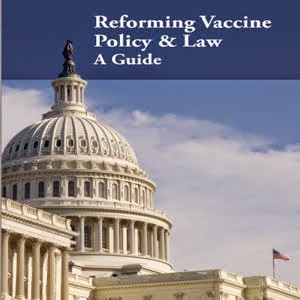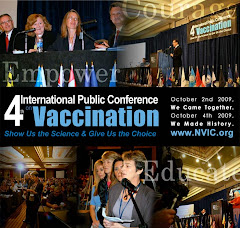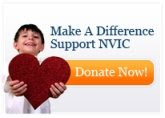Fear of the unknown is what terrifies us the most, fear of being unable to have control over what the future holds. At the root of that fear is knowing that the choices we make today could have a profound impact on what happens tomorrow. 1 Fear is a strong emotion that helps people take action but fear does not help people think clearly and make well informed choices. 2, 3
Fear has dominated the public debate about the risks of infectious diseases and the risks of vaccination during the past three decades. 4, 5, 6, 7, 8 Now it is jeopardizing the urgent need to create a supportive environment for researchers to conduct well designed studies to answer outstanding questions about vaccine safety, questions that the Institute of Medicine pointed out in 19919 and 1994 10 needed to be answered and that the National Vaccine Advisory Committee outlined in 2009 and 2010 during a public engagement initiative. 11
Getting lost in the avalanche of accusations, finger pointing and demonization of individuals challenging the status quo 12, 13, 14, 15 is the more important question: What can be done now to fill in gaps in the science that stand in the way of our making well informed vaccine choices and public health policy based on evidence and not fear? 16, 17, 18, 19, 20, 21, 22
On January 3-7, 2011, a vaccine safety conference was held in Montego Bay, Jamaica that included a diverse groups of delegates from around the world, including senior scientists and physicians, editors of scientific journals, experts in vaccine regulation, social science and health policy, consumer child health advocates, legal experts and members of the media. 23 Public observers in the audience included Jamaican physicians, wellness practitioners, graduate and medical students in public health programs and parents.
The international meeting was underwritten by individuals and private family foundations and co-sponsored by the National Vaccine Information Center. The goal was to further evaluate vaccine safety science and vaccine policy in light of the fact that 89 percent of recently polled American parents put vaccine safety at the top of their list of medical research priorities, 24 while health consumers in other developed countries are also questioning the quality of vaccine science. 25, 26
All of the delegates expressed concern about increases during the past three decades in the numbers of children and adults affected by immune and inflammatory diseases, ranging from asthma 27 and neurodevelopmental disorders 28, 29, 30 to the emergence of previously rare but serious autoimmune health conditions.31, 32 Many delegates presented information from the peer reviewed scientific literature and pointed out gaps in knowledge about the biological mechanisms for vaccine induced brain and immune dysfunction, 33 as well as the fact there is inadequate information about:
One: Genetic and biological high risk factors 34, 35 for vaccine injury and death;
Two: Vaccine safety data, especially for delayed or chronic health outcomes;
Three: Vaccine additives, including aluminum adjuvants, which are immune stimulating agents, as well as mercury preservatives;
Four: Multiple vaccinations given simultaneously or repeatedly over time;
Five: Bias in reporting of vaccine risks and benefits; and
Six: Novel vaccine-associated autoimmune diseases.
There was discussion about the need to identify research priorities and design studies to identify how and why some children and adults may be at higher risk for vaccine reactions that lead to chronic health problems or even death.
There was discussion about the need to minimize undue commercial and political influence on academic institutions, medical journals and lay press because it gets in the way of open, unbiased scientific inquiry, 36, 37, 38, 39 especially into important questions about vaccine safety science and policy.
Representatives of federal agencies responsible for vaccine regulation, promotion, and safety were invited to present at this important conference but declined the invitation. And that fact speaks louder than words about how great the divide is between those who regulate vaccines and make vaccine policy and the people, who must adhere to that policy.
The men and women with vision and integrity, who are stepping forward to conduct and fund independent research to fill in knowledge gaps about vaccine safety, are to be congratulated for having the courage to stand up during a time when the public conversation about vaccination is dominated by fear. Hopefully, in 2011, new vaccine science that adheres to high standards will generate evidence to help bridge the divide between those, who believe all vaccines are necessary, safe and effective, and those who have serious concerns.
Referenced presentations and video excerpts from the meeting in Jamaica will be posted on the web in spring 2011. For more information, go to www.vaccinesafetyconference.com
REFERENCES
1 Rosenberg C. Managed Fear. The Lancet 2009; 373 (9666); 802-803. http://www.thelancet.com/journals/lancet/article/PIIS0140-6736(09)60467-0/fulltext
2 Lerner JS, Keltner D. Fear, Anger, Risk. Journal of Personality and Social Psychology 2001. 81(1): 146-159. http://greatergood.berkeley.edu/dacherkeltner/docs/lerner.fear.jpsp.2001.pdf
3 Maitlis S, Ozcelik H. Toxic Decision Processes: A Study of Emotion and Organizational Decision Making. Organization Science 2004; 15(4): 375-393. http://www.compassionlab.com/docs/maitlis-ozcelik2004.pdf4 Foster KR. Epidemics of Fear (Book Review of Dread: How Fear and Fantasy Has Fueled Epidemics from the Black Death to Avian Flu by Philip Alcabes). Science 2009; 324(5933): 1393.
5 Van Damme W, Van Lerberghe WV. Epidemics and Fear. Tropical Medicine and International Health 2000; 5(8): 511-514.6 Gonzalez ER. TV report on DTP galvanizes US pediatricians. JAMA 1982; 24(1): 12-22.
7 Fauci AS. Smallpox Vaccination Policy – The Need for Dialogue. NEJM 2002; 346: 1319-1320.8 Annas GJ. Bioterrorism, Public Health and Civil Liberties. NEJM 2002; 346: 1337-1342.
9 Howson CP, Howe CJ, Fineberg HV, editors. Adverse Effects of Pertussis and Rubella Vaccines. Institute of Medicine, National Academy Press 1991.10 Stratton KS, Howe CJ, Johnston RB, Jr., editors. Adverse Events Associated with Childhood Vaccines: Evidence Bearing on Causality. Institute of Medicine, National Academy Press: 1994.
11 National Vaccine Advisory Committee. Recommendations of the Centers for Disease Control and Prevention Immunization Safety Office Draft – 5 Year Scientific Agenda. National Vaccine Advisory Committee: June 2, 2009.12 Offit PA, Moser CA. The Problem with Dr. Bob’s Alternative Vaccine Schedule. Pediatrics 2009; 123(1): 164-169.
13 Wallace A. An Epidemic of Fear: How Panicked Parents Skipping Shots Endangers Us All. Wired Magazine: October 19, 2009.14 Fisher BL. Amy Wallace and Yellow Journalism. Vaccine Awakening: September 9, 2010.
15 Offit P. Deadly Choices: How the Anti-Vaccine Movement Threatens Us All. Basic Books: 2011.16 Fisher BL. Vaccine Adverse Event Reporting & Data Collection. Statement presented to Institute of Medicine Vaccine Safety Forum. November 6, 1995.
17 Fisher BL. Vaccine Adverse Event Detection Methodologies. Statement presented to Institute of Medicine Vaccine Safety Forum. November 6, 1995.18 Fisher BL. Vaccine Safety Research Needs: Perspective from Parents. Statement presented to Institute of Medicine Vaccine Safety Forum. April 1, 1996. and Institute of Medicine Vaccine Safety Forum. Summaries of Two Workshops: Detecting and Responding to Adverse Events Following Vaccination and Research to Identify Risks for Adverse Events Following Vaccination Biological Mechanisms and Possible Means of Prevention. National Academy Press 1997.
19 Fisher BL. The Hepatitis B Vaccine: Adverse Events. Invited testimony for the Criminal Justice, Drug Policy and House Resources Subcommittee of the House Government Reform Committee. May 18, 1999.
20 Fisher BL. Vaccine Safety Concerns of Parents. Invited presentation to Institute of Medicine Immunization Safety Review Committee. January 11, 2001.21 Fisher BL. Vaccine Safety Research Priorities: Engaging the Public. Invited presentation to the Vaccine Safety Working Group, National Vaccine Advisory Committee. April 11, 2008.
22 Institute of Medicine Committee on the Review of the National Immunization Program’s Research Procedures and Data Sharing Program, Board on Health Promotion and Disease Prevention. Vaccine Safety Research, Data Access AND Public Trust. The National Academies Press 2005.23 Business Wire. Vaccine Safety Conference Outlines Research Gaps. News-Medical.net
January 10, 2011.
25 Samad L, Tate AR et al. Differences in risk factors for partial and no immunization in the first year of life: prospective cohort study. BMJ 2006; 332(1312).
26 Shetty P. Experts concerned about vaccination backlash. The Lancet 2010; 375 (9719): 970-971.27 Centers for Disease Control. Press Release: State of Childhood Asthma, U.S. 1980-2005. CDC: December 12, 2006. Full Report: http://www.cdc.gov/nchs/data/ad/ad381.pdf
28 Landrigen PJ. Children’s Environmental Health. Population Reference Bureau: July 2001.29 Field MJ, Jette AM. The Future of Disability in America (Chapter 3 – Disability Trends). National Academies Press: 2007.
30 Centers for Disease Control. CDC Study: An average 1 in 110 children have an ASD. CDC: 2010.31 Nakazawa DJ, Kerr D. The Autoimmune Epidemic. Simon & Schuster: 2009.
32 Davidson A, Diamond B. Autoimmune Diseases. NEJM 2001; 345: 340-350.33 See References #9,10, 11.
34 Mak TW, Simond JJL. HLA, Genetic Predisposition and the Immune System. In Handbook of Immune Responses 1998; 171-201.35 Ingelman-Sundberg M. Pharmacogenomic Biomarkers for Prediction of Severe Adverse Drug Reactions. NEJM 2008; 358:637-639.
36 Abraham J. The pharmaceutical industry as a political player. The Lancet 2002: 360: 1498-502.37 Lexchin JR. Implications of Pharmaceutical Industry Funding on Clinical Research. Annals of Pharmacotherapy 2004; 39(1): 194-197.
38 De Angelis C. Fontamarosa PB. Impugning the Integrity of Medical Science: The Adverse Effects of Industry Influence. JAMA 2008; 299(15): 1833-1835.
39 Consumer Reports. Consumer Reports Health Poll Two-Thirds of Americans Say Drug Makers Have To much Sway Over Doctors: Information About Safety and Side Effects Sorely Needed. PR Newswire August 24, 2010.
Watch the video:






